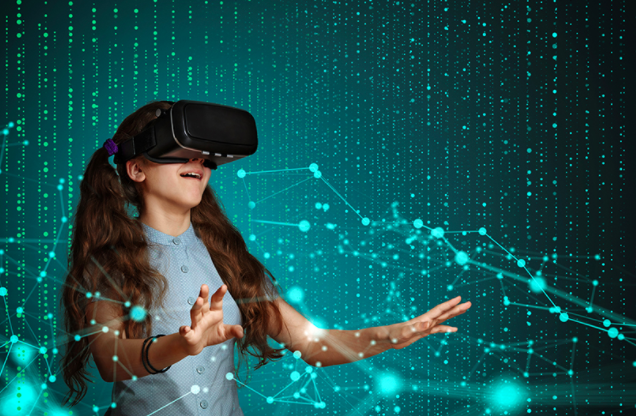5 Insights on the Future of VR Technology
Every day, innovative technologies are changing how we live our lives and how companies conduct business. Although virtual reality isn’t all that new of an innovation, the first VR headset was patented in 1960, there have been incredible advances in the development of VR over the years.
These advancements have made it possible for gamers to dive into fantasy worlds where they can slay Orcs or fly a fighter jet, but VR isn’t just for fun and games.
Although no one can truly say what the future holds for virtual reality, there are a few real-world applications where we see virtual reality starting to make waves.
1. Blockchain and Cryptocurrency Merges Into One
The popularity of cryptocurrencies like Bitcoin, there are over 1,300 cryptocurrencies on the market as of November 2017, continues to ebb and flow, but the allure of it still entices many.
Now you can trade virtual currency for real-life goods in certain online markets just by mining on the blockchain. If your not familiar with the term, blockchain is a digital ledger that records and stores any and all previous transactions.
Mining for cryptocurrency used to require expensive hardware that could cost as much as $3,000 for the best mining setup, but now people can invest in bitcoin cloud mining that doesn’t require hardware, software, electricity, and other factors.
However, for those who want a more immersive experience while using and mining for cryptocurrency people are turning to the blockchain-based virtual universe called Decentraland.
Decentraland is a VR platform where users can buy virtual land, make connections with other users, and create content in exchange for more content and even real money.
Decentraland isn’t the only company that’s working to combine VR and blockchain together. CEEK VR is a company that creates VR hardware, and they run a platform that uses blockchain to enable artists to broaden their reach and connect with their fans from all over the world to view a virtual concert.
2. Virtual Reality Possibly Becoming the Next Computing Platform
People like Mark Zuckerberg, creator of Facebook, believe that virtual reality is going to be used for more important things than gaming, filmmaking, and other means of entertainment. He believes that it could be the next major computing platform. In a 2016 Bloomberg interview, he talked about his optimism about virtual reality possibly becoming one of the main ways we communicate.
“Photos are richer than text; video, much richer than photos. But that’s not the end, right? I mean, it’s like this indefinite continuum of getting closer and closer to being able to capture what a person’s natural experience and thought is, and just being able to immediately capture that and design it however you want and share it with whomever you want.”
Of course, it’s important to note that virtual reality technology is still being developed and refined, so this type of computing capability is still a way off.
3. Using VR to Treat Post-Traumatic Stress Disorder
It should be no surprise that various forms of technology are being used in hospitals; whether it is to keep track of patient records through the use of electronic health records (EHRs), barcoding, and radio-frequency identification (RFID) tags. In fact, almost 90% of hospitals in the United States have basic EHRs.
By introducing virtual reality to patients who suffer from PTSD, hospitals can give patients a VR headset to help them reduce the symptoms they experience. The VR technology uses high-end computer graphics rendered in 3D, along with multi-sensory feedback to give the patient the illusion of being in that environment. With the help of a trained therapist, the patient will be guided through their fears.
VR isn’t just being used to treat PTSD, it is also being used to prevent the development of PTSD by providing mental resilience training to active duty soldiers or others who are in a high risk group.
4. Businesses Adopting Virtual Reality
As it is right now, the majority of people use some form of social media to interact with others. These online networking sites give people the opportunity to connect with their peers in ways that time and location may not always allow.
People don’t just use social media for leisure, many use it to further their career – or just find a job after graduating. 86% of recent MBA graduates use some form of networking to find a job.
Just imagine how unique the experience would be when meeting a potential employer who is across the country, from the comfort of your home. Virtual reality could change the way employers go about hiring new employees!
In that vein, VR could even change how business is conducted. Personnel could attend meetings without needing to leave their own offices. Even inventory could be taken in a warehouse in another country. Virtual reality has the potential to change a lot of how businesses are ran.
5. Sharing Personal Experiences With Virtual Reality
Virtual reality already has proven to be a great innovation for entertainment. Those late night movie marathons with your loved one could be so much more exciting when you feel like you’re immersed in that world together.
But, what if there was a way for each person to have a shared VR experience within a single setting?
At the 2018 Sundance Film Festival, this thought was explored by way of various social interactive VR experiences that ranged from animation to documentary. In these projects participants were secluded from one another physically, but they were able to interact with each other and their environment via the VR equipment.
There was also a real-time VR instillation called “VR-I,” which was a collective dance experience created by Gilles Jobin, Sylvaian Chaqué, and Caecilia Charbonnier. The instillation mapped the user’s body via infrared cameras that followed the trackers on the user’s feet, hands, and computer backpack. Each user became one of the five real dancers created by precise 3D rendering scans and motion capture systems.
Conclusion
Imagine a world where you could experience things that you never thought possible. Virtual reality is already making a name for itself in the gaming and entertainment communities, but there can be so many more uses for it.
People can use VR to treat the debilitating symptoms of PTSD. It can be used to network with potential employers in a way that regular social media cannot. It can be used to have a shared virtual experience with other people, or just connect with loved ones in a whole new way.
It can even be used to build a world that you envision yourself in, while earning real world dollars! In a way, virtual reality can make anything possible, if we will it to be so.

